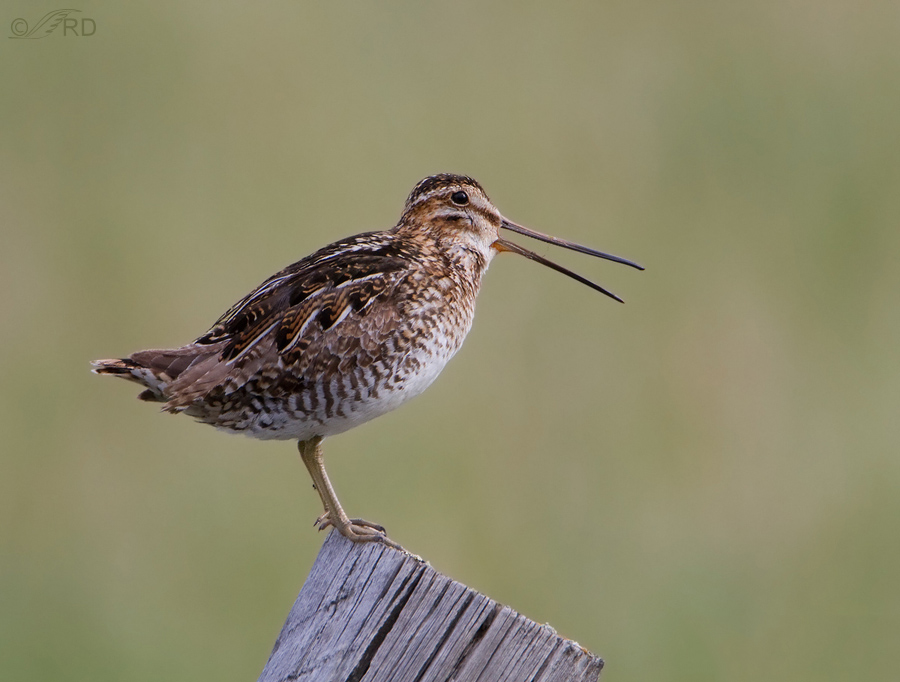Wilson’s Snipe is an elusive species. Relatively little is known of its habits due to its crepuscular nature, cryptic coloration and marshy habitat. Even with as much time as I’ve spent on their stomping grounds I can count on one hand, with a few fingers amputated, the number of times I’ve photographed a snipe. Typically it’s only seen as it flushes in zigzag flight, calling out with its raspy voice.
What an interesting bird! The word snipe is derived from “snite” – a variant of snout and you can see why. Their eyes are set remarkably far back on their head, giving them full vision on both sides and binocular vision to the rear. This allows them to see predators approaching from behind, even while their beak is buried in the mud.

1/640, f/6.3, ISO 500, 500 f/4, natural light
I found this bird along the Red Rock River in Montana’s Centennial Valley. It was a low light situation so I didn’t have much shutter speed and I was mildly surprised to get the beak sharp as it was calling. The snipe gave me only a few seconds before it flew off, scolding me as it went.
Ron


When I originally left a comment I appear to have clicked on the -Notify me
when new comments are added- checkbox and from now on every time a comment is added I receive 4 emails with the exact same comment.
Perhaps there is an easy method you are able to remove me
from that service? Appreciate it!
Hi Yvette,
I don’t blame you. It really annoys me when unnecessary emails junk up my inbox.
Actually the “notify me of new comments on this post”function is a WordPress thing that I have no control over. However, at the bottom of those emails should be a link you can check to unsubscribe from those notifications.
Please let me know if it doesn’t work.
Ron:
This post led me on a merry chase. My version of Sibley doesn’t list Wilson’s, only Common Snipe. My iBirdPro, lists both and under Identify/Similar Species states that Wilson’s Snipe has much less orange wash on its flanks, and black and white stripes at base of underwing are of equal width. Yet iBirdPro gives same scientific name to Wilson’s and Common. Elsewhere on the web (e.g. web4.audubon.org/bird/BOA/F36_G6a.html )Common and Wilson’s are treated as the same.
Confusing?
Dave
Yes Dave, “confusing” is the right word. I ran into some of the same issues for this post so I went with BNA Online, as I usually do, because they seem to be pretty current on this kind of thing. Here’s what they say:
“Historically considered both a subspecies of the Common Snipe (G. gallinago) and distinct from that species, recent taxonomy has concluded that differences in both winnowing display sounds and morphology allow full specific status for these close relatives”
More about my experiences with these birds. In Eldorado, TX, they have these water treatment ponds. Five in all, each separated by a narrow lane that you can drive your drive your vehicle. Of course, each one is also bordered with rocks, reeds, and grasses. A person can drive slowly, as you and I do, and watch carefully into the grasses. When in your vehicle you are only about 15 feet away from the shore line and about 3 feet above it. So once you spot one of these snipes, it is easy to get photos. But, as I said in my other comment, spotting it can be the hardest part. They kinda hide in plains sight.
Bob, I’m sure there have been many times when I’ve been close to one and didn’t have a clue.
That’s so great that you found him with such a wonderful background. Usually when I find them, they’re surrounded by a cluttered mess.
Me too Scott – when I find them, which isn’t often.
What a bizarre looking bird. I am so grateful that you luck in capturing it on camera is also ours. Thank you.
I agree that they look a little bizarre Elephant’s Child, largely because their beak almost seems to come out of their neck instead of their face.
I love photographing those Wilson’s Snipes. I have had the experience several times at a wetlands area south of here in Eldorado. I was able to photograph them from my car as usual, but the hard part is seeing them. I have looked directly at them and didn’t see them, because they were blending in with the grasses. They’re little cuties.
Thanks Bob, sounds like you’ve had more success with them than I have.